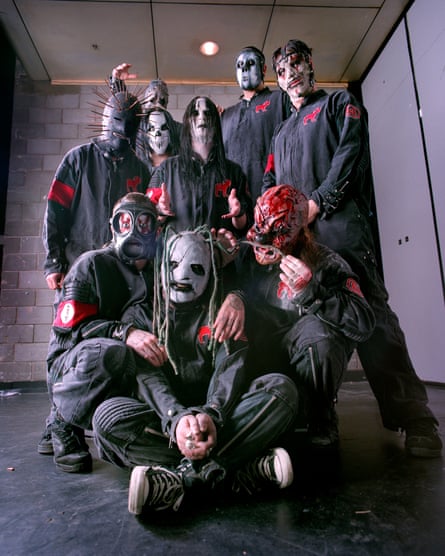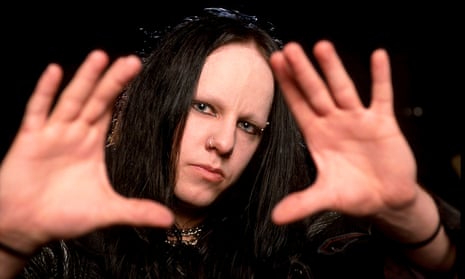To better understand the magnitude of former Slipknot drummer Joey Jordison’s death at the age of 46 requires us to first recall the loss of another drummer. Praised universally for his technical wizardry and powerhouse style, Rush’s legendary Neil Peart died in January 2020 – a watershed moment for rock drumming. Eighteen months later, we now face the heavy metal equivalent.
While there’s a strong case for Slipknot as the greatest metal band of their generation, Jordison was almost definitively the finest metal drummer of his era. Born in the band’s native Des Moines, Iowa, Jordison picked up his first pair of drumsticks aged eight. He co-founded the nine-piece Slipknot in 1995 and spent 18 years behind the kit for the megastars. Slipknot developed their own lore: there were the obvious nods to horror in the terrifying face masks and boiler suits they wore for live performances, and each member was assigned their own number. Tellingly, Jordison was No 1.

He performed on four official studio albums and one live album, cultivating a fast and furious drumming style characterised by blistering double pedal kicks and frightening hand speed. Such was his influence on both Slipknot and the new wave of American heavy metal that in 2005 he was selected as one of four team captains to lead Roadrunner Records’ All-Star Sessions, in which 57 artists from the label’s history recorded a new album to mark its 25th anniversary. Jordison even filled in for Lars Ulrich at a now-fabled Metallica set at Download festival in 2004, cementing his reputation as one of the most influential drummers of the 21st century and one of the key personalities in modern metal.
If Peart was “The Professor”, Jordison was “The Butcher”. His devastating combination of breakneck speed and fierce impact sliced through two decades of Slipknot’s visceral noise. But even at his most ferocious, his playing was always underpinned with a sense of controlled chaos. Take the band’s nihilistic anthem and frequent concert opener People = Shit: in the opening 25 seconds, Jordison slaloms through explosive blast beats, frenzied fills and formidable double-kick passages like a man possessed. And there’s still three minutes of the song to go.
Physically, Jordison didn’t have the mass of a Peart or a John Bonham, standing at just over five foot. During Slipknot’s 2000s heyday, someone less acquainted with the band could easily have mistaken him for a diminutive teenager. It made his prowess awe-inspiringly inconceivable: that he could conjure up the strapping, rhythmic hulk on Psychosocial, or the savage snare drum strikes on Eyeless. Jordison was a percussive force of nature that captivated the ever-faithful Maggots – the band’s name for their fans – night after night. Even up against the jagged might of Jim Root and Mick Thomson’s guitars, or Corey Taylor’s guttural screams, Jordison made his mark. No other drummer in metal was as instantly identifiable by snare tone alone. That violent crack punctured through almost everything – just listen to The Blister Exists.
Tragedy struck Slipknot in 2010 when bassist and fellow co-founder Paul Gray died of an accidental drug overdose. The original Nine, as they were known, was broken. Three years later, Jordison left under murky circumstances: the band said he had departed for personal reasons; Jordison claimed he had been fired and said he was “blindsided” by their statement and that he “did not quit Slipknot”. It wasn’t until 2016 that Jordison revealed that he had temporarily lost the use of his left leg, and with it, his ability to play drums after being diagnosed with the rare neurological condition transverse myelitis, which had also made him appear intoxicated on stage during his final shows with Slipknot.
In an interview with Metal Hammer, Jordison rued that his close friends had fired him by letter. “They got confused about my health issues, even I didn’t know what it was at first,” he said. “They thought I was fucked-up on drugs, which I wasn’t at all. I don’t blame them for being concerned, but when you’re friends and you’ve been through so much stuff, you fucking talk to each other. But I harbour no bad feelings toward them at all, because I’ve moved on with my life. I’m happier than I’ve been in years. You need to move on, close the fucking chapter and, in the end, it is what it is.”
After a lengthy period of rehabilitation, Jordison would drum again, joining the death metal supergroup Sinsaenum in 2016 and forming his own band, Vimic. It was testament to Jordison’s force of will and commitment to a life in music outside the behemothic metal band, his legacy as Slipknot’s co-founder and talismanic original drummer long secured.
